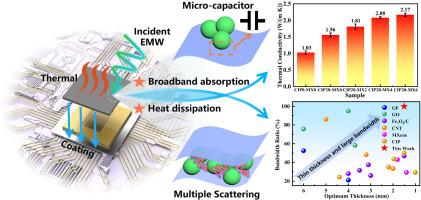Multiscale magnetic-electric synergy in CIP/MXene/epoxy nano-micro composites for ultra-broadband absorption and enhanced thermal conductivity
IF 9.8
1区 材料科学
Q1 MATERIALS SCIENCE, COMPOSITES
引用次数: 0
Abstract
Electromagnetic waves (EMWs) in the millimeter-wave (MMW) to terahertz (THz) range have attracted significant attention due to their applications in wireless communications, security imaging, radar detection, and atmospheric or astrophysical research. However, the utilization of high-frequency EMWs presents challenges, particularly in electromagnetic compatibility and thermal management. In this study, we developed a composite coating with both excellent EMWs absorption and high thermal conductivity by integrating carbonyl iron powder (CIP) microspheres, MXene nanosheets, and epoxy (EP) resin. By harnessing the multiscale complementarity of CIP microspheres and MXene nanosheets, as well as the synergistic effects of low-frequency magnetic loss and high-frequency electric loss mechanisms, the composite coating achieved ultra-broadband absorption across the MMW (26.5 GHz) to THz (3 THz) range with a thickness of only 1.5 mm. The average reflection loss (ARL) of the coating is as low as −15.36 dB, and it maintains stability at temperatures up to 300 °C, with a high thermal decomposition temperature of 439.6 °C. These results indicate that the coating can effectively mitigate external electromagnetic interference (EMI) and device heating when applied to electronic components. This research offers an innovative solution to address both EMI effects and thermal management challenges in high-frequency broadband electromagnetic systems.

CIP/MXene/环氧纳米微复合材料中多尺度磁电协同作用的超宽带吸收和增强导热性
毫米波(MMW)到太赫兹(THz)范围内的电磁波(emw)由于其在无线通信,安全成像,雷达探测以及大气或天体物理研究中的应用而引起了极大的关注。然而,高频emw的使用带来了挑战,特别是在电磁兼容性和热管理方面。在这项研究中,我们通过整合羰基铁粉(CIP)微球、MXene纳米片和环氧树脂(EP),开发了一种既具有优异的emw吸收性能又具有高导热性的复合涂层。通过利用CIP微球和MXene纳米片的多尺度互补性,以及低频磁损耗和高频电损耗机制的协同效应,复合涂层实现了毫米波(26.5 GHz)到太赫兹(3thz)范围内的超宽带吸收,厚度仅为1.5 mm。该涂层的平均反射损耗(ARL)低至−15.36 dB,在高达300℃的温度下保持稳定,热分解温度高达439.6℃。这些结果表明,该涂层可以有效地减轻外部电磁干扰(EMI)和器件加热。这项研究为解决高频宽带电磁系统中的EMI效应和热管理挑战提供了一种创新的解决方案。
本文章由计算机程序翻译,如有差异,请以英文原文为准。
求助全文
约1分钟内获得全文
求助全文
来源期刊

Composites Science and Technology
工程技术-材料科学:复合
CiteScore
16.20
自引率
9.90%
发文量
611
审稿时长
33 days
期刊介绍:
Composites Science and Technology publishes refereed original articles on the fundamental and applied science of engineering composites. The focus of this journal is on polymeric matrix composites with reinforcements/fillers ranging from nano- to macro-scale. CSTE encourages manuscripts reporting unique, innovative contributions to the physics, chemistry, materials science and applied mechanics aspects of advanced composites.
Besides traditional fiber reinforced composites, novel composites with significant potential for engineering applications are encouraged.
 求助内容:
求助内容: 应助结果提醒方式:
应助结果提醒方式:


